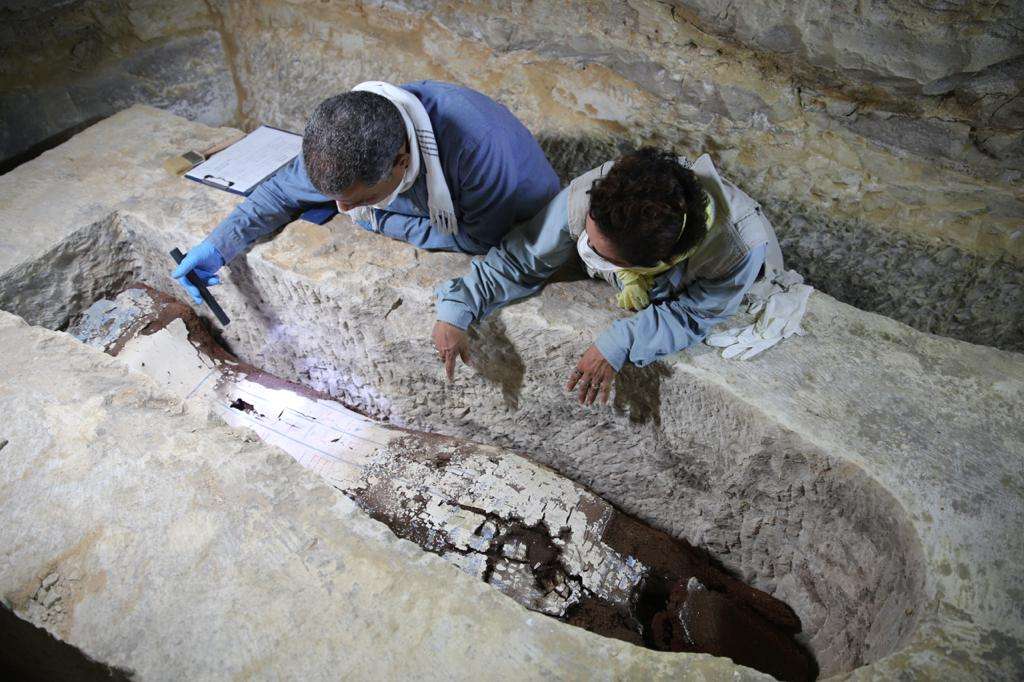A new burial chamber was uncovered at the bottom of the Mummification Workshop's municipal burial shaft (30 m deep), which was discovered in 2018 along with a large grave complex with five burial chambers.
This came during the excavation work carried out by the University of Tübingen's Egyptian-German team, operating at Saqqara.
The project found the sixth burial chamber concealed behind a 2600-year-old stone wall, after more than a year of exploration and documentation. Dr. Mostafa Waziri, Secretary-General of the Supreme Council of Antiquities declared that the newly discovered chamber held four poorly preserved wooden coffins.
Dr. Ramadan Badri Hussein pointed out to a woman named Didibastett who belongs to one of the coffins. She was buried with six Canopic jars that refute ancient Egyptian costume to embalm the deceased's lungs, stomach, intestines, and liver, and then store them in four jars under the protection of four gods, revered as the Four Sons of Horus.
The Mission used computerized tomography (CT) scan to examine the content of Didibastet's two extra canopic jars, and the preliminary analysis of the images indicates that the two jars contain human tissue.
Based on this result, Didibastet may have received a special form of mummification which preserved six of her body's organs. The radiologist at the Mission is currently conducting an in-depth study of the images to identify the two extra organs.
After examining the texts in the burial chambers on the coffins and sarcophagi, the mission named priests and priestesses of a mysterious snake goddess, known as Niut-shaes.
Indications are that Niut-shaes priests were buried together, and she was made a popular goddess during Dynasty 26. Maybe, in Memphis, the administrative capital of ancient Egypt, she had a large temple.
Possibly Egyptianized immigrants were a priestess and a priest of Niut-shaes who had been buried in the same chamber. Their titles, Ayput and Tjanimit, were common among the Libyan group which had settled in Egypt since Dynasty 22 (ca. 943-716 BC).
Ancient Egypt was a multicultural society that welcomed, refugees from different parts of the ancient world, including Greeks, Libyans, and Phoenicians.
Dr. Ramadan Badri said the mission carried out non-invasive research, called X-ray fluorescence, on the gilded silver mask discovered on the face of the mummy of a goddess Niut-shaes priestess. This check determined 99.07 percent of the purity of the silver mask, higher than 92.5 percent of Sterling Silver.
This gold-silver mask is the first one ever to be found in Egypt since 1939, and the third of these masks ever to be found in Egypt.
An international team of archaeologists and chemists from the University of Tübingen, the University of Munich, and the Egyptian National Research Center in Cairo performed chemical testing of the residue of oils and resins contained in mummification workshop cups, bowls, and pots. Recent test results include a list of mummification compounds, including bitumen (tar.)
Dr. Ramadan said: "Mummification was a business transaction between an inpidual and an embalmer in which the embalmer was a specialist, a priest, and a businessman. We know from many papyri that there was a class of priests and embalmers who were paid to arrange for the funeral of a deceased, including the mummification of his / her body and the purchase of a grave or a coffin."
Contributed by Ahmad El-Assasy



















